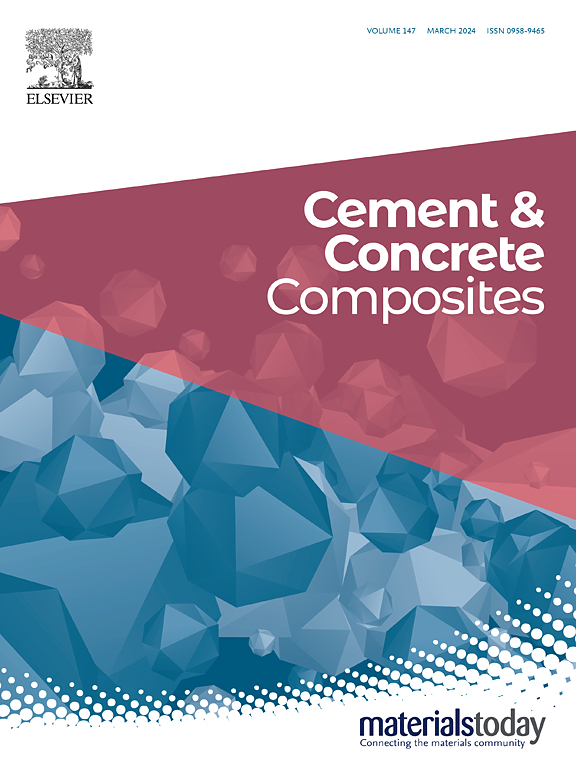C-S-H种子和硫酸盐在含粉煤灰微球的轻质胶凝复合材料中的作用
IF 13.1
1区 工程技术
Q1 CONSTRUCTION & BUILDING TECHNOLOGY
引用次数: 0
摘要
基体强度和骨料与基体之间的界面结合力是影响轻质胶凝复合材料性能的关键因素。本研究提出了一种利用硫酸钠(SS)和水合硅酸钙(C-S-H)种子相结合开发高性能含粉煤灰微球(FAC)的环保高效策略。从水化、微观结构、孔隙结构和界面区等方面阐述了SS和C-S-H种子对LCC获得优异强度的作用。结果表明:C-S-H种子与SS的联合使用加速了硅酸盐与铝酸盐的水化作用,缩短了LCC的凝结时间,细化了LCC的孔径;FAC颗粒由于铝浓度的增加和界面上石膏的形成,为钙矾石的析出提供了成核场所。此外,C-S-H种子和SS显著改善了FAC与基质之间的界面区,这是由于FAC的火山灰反应性增强。C-S-H种子和SS主要通过物理成核和化学活化来提高基体强度和界面区,从而形成高性能的LCC。结果表明,LCC的早期和晚期抗压强度分别提高了131.4±19.8%和29.0±5.1%。这些发现为开发高强度轻质混凝土提供了一种新的途径,可以提高混凝土在环境养护下的早期强度。本文章由计算机程序翻译,如有差异,请以英文原文为准。
Understanding the role of C-S-H seeds and sulfate in the lightweight cementitious composites containing fly ash cenospheres
Matrix strength and interfacial bonding between aggregate and matrix are critical factors influencing the performance of lightweight cementitious composites (LCC). This study proposes an environmentally friendly and efficient strategy for developing high-performance fly ash cenospheres (FAC)-containing LCC by combining sodium sulfate (SS) and calcium-silicate-hydrate (C-S-H) seeds. Moreover, the roles of SS and C-S-H seeds on achieving superior strength of LCC were elaborated by characterizing the hydration, microstructure, pore structure, and interfacial zone. Results show that the combined use of C-S-H seeds and SS accelerated silicate and aluminate hydration, shortened the setting time of LCC, and refined the pore size. FAC particles provided a nucleation site for the precipitation of ettringite due to the increased aluminum concentration and formation of gypsum on interface. Furthermore, C-S-H seeds and SS significantly improved the interfacial zone between FAC and matrix due to the enhanced pozzolanic reactivity of FAC. C-S-H seeds and SS primarily functioned through a physical nucleation and chemical activation to improve the matrix strength and interfacial zone, respectively, resulting in a high-performance LCC. Consequently, remarkable increases of 131.4 ± 19.8 % and 29.0 ± 5.1 % in early and late compressive strength of LCC were achieved. These findings present a novel approach for developing high-strength lightweight concrete with enhanced early strength under ambient curing.
求助全文
通过发布文献求助,成功后即可免费获取论文全文。
去求助
来源期刊

Cement & concrete composites
工程技术-材料科学:复合
CiteScore
18.70
自引率
11.40%
发文量
459
审稿时长
65 days
期刊介绍:
Cement & concrete composites focuses on advancements in cement-concrete composite technology and the production, use, and performance of cement-based construction materials. It covers a wide range of materials, including fiber-reinforced composites, polymer composites, ferrocement, and those incorporating special aggregates or waste materials. Major themes include microstructure, material properties, testing, durability, mechanics, modeling, design, fabrication, and practical applications. The journal welcomes papers on structural behavior, field studies, repair and maintenance, serviceability, and sustainability. It aims to enhance understanding, provide a platform for unconventional materials, promote low-cost energy-saving materials, and bridge the gap between materials science, engineering, and construction. Special issues on emerging topics are also published to encourage collaboration between materials scientists, engineers, designers, and fabricators.
 求助内容:
求助内容: 应助结果提醒方式:
应助结果提醒方式:


